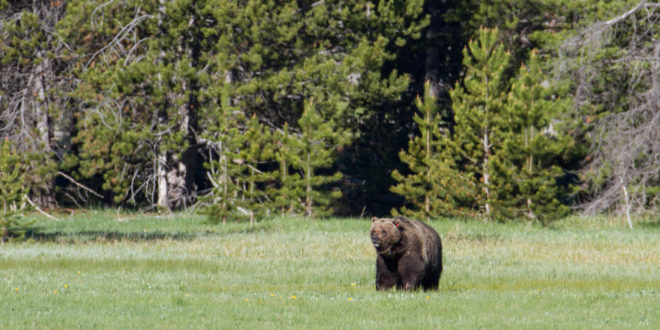A new study shows some Yellowstone grizzlies may be adapting in the face of declining whitebark pine—but that more study is needed.
According to Phys.org, a new study from the University of California San Diego and Unity College, published in PLoS ONE, looks at the dietary habits of grizzly bears living in Montana’s Cooke City Basin. The study also cites work from researchers at Montana State University.
Using isotopic data, researchers showed some bears are switching over to more plants and berries as whitebark pines continue to die off, cutting off the supply of pine seeds in the region. From Phys.org:
Once ubiquitous in western North America, the slow-growing whitebark pine trees have declined in recent decades and are now listed as endangered by the International Union for Conservation of Nature. Warming temperatures have led to shorter and milder winters, increasing beetle infestations and further threatening whitebark pine mortality. Other potential food sources for grizzlies such as trout and ungulates have also declined in the region.
“Whitebark pine trees have declined due to an introduced fungal disease called blister rust, and, more recently, to increased infestation by the mountain pine beetle, which is exacerbated by climate change,” said study coauthor Carolyn Kurle, an assistant professor at UC San Diego’s Division of Biological Sciences. “Such declines further highlight the need to monitor diets of grizzlies as the environment continues to change.”
Lead author Jack Hopkins, a former postdoctoral researcher in Kurle’s lab at UC San Diego and currently an assistant professor at Unity College, and his team measured stable isotopes in bear hair and related their abundances to those found in their foods.
“Stable isotope analysis is a powerful ecological tool for reconstructing the diets of animals,” said Hopkins. “Instead of investigating the diets of animals based on what’s eliminated (feces), we estimate the importance of major food sources to animals based on what’s assimilated into their tissues. Using stable isotope analysis to conduct a retrospective diet analyses can shed light on how animals, such as Yellowstone grizzlies, have responded to changes in food availability on the landscape.”
Whitebark pine seeds are a fall staple for Yellowstone grizzlies, which rely on them (in part) ahead of the breeding and hibernation season.
Declines in whitebark pine, spurred on by climate change, paired with uncertainty as to how Yellowstone grizzlies will adapt to the loss of a food staple, is partly why Yellowstone grizzlies are still on the Endangered Species List—in spite of signals from the U.S. Fish and Wildlife Service that the bears are slated for delisting.
Indeed, when bears were temporarily delisted in 2007, a U.S. District Judge restored protections two years later, citing the decline of whitebark pine in Yellowstone. David Mattson, a former Interagency Grizzly Bear Study Team researcher and grizzly advocate, argues any decision to delist the bears flies in the face of sound science, adding that a shift in diet away from pine nuts is associated with increased risk of grizzly mortality, especially at the hands of wildlife managers.
Hopkins told Phys.org the group’s study should be applied to other regions and other species of concern. “Such analyses could be used to monitor grizzly bear recovery efforts and inform other wildlife conservation and management programs worldwide.”
 Yellowstone Insider Your Complete Guide to America's First National Park
Yellowstone Insider Your Complete Guide to America's First National Park





